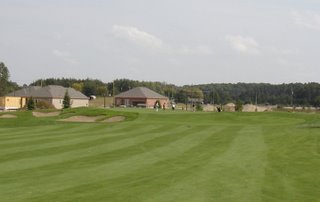Dealing With Flat Sites

The TPC at Sawgrass was one of the best courses ever built on a por site. Dye lifted the fairways and used bunkering as transition.
Greg asked, “How you would work with a flat piece of land. Is this a golf architect's worst nightmare, or something better? Does a flat piece of land provide more options, or fewer? What are the main things that drive a flat design? What would you do with a wooded lot vs. a clear lot?”
The good is that you have almost complete artistic freedom to create exactly what you want. The bad is that no matter how hard you try, you will always be limited by the flatness of the site.
The key to handling it becomes making a decision on how to provide some relief to the holes to make the course interesting. The old standard of placing containment mounds around the outside of holes makes for a horrible and unnatural golf course. The key is to create a natural feature like a sand quarry or a ridgeline to add at least one prominent landscape element from which you work from. The pit can be used to create the fill needed to lift areas such as tees and green – even fairways too. The ridgeline running through the middle allows you to use it for backdrops and to provide views out over the property to situate tees greens and even fairways.
A flat site is not an architect’s worst nightmare, but it presents a very complicated build for drainage and a very average starting point which usually doesn’t lead to a great golf course – unless an architect has an immense imagination and a good solid budget to work with. Built on the cheap, there is very little an architect can do to overcome the site.
The architecture for a flat property can have the most options since it is limited only to the imagination and the earthmoving budget. You are left to create it all, which suits someone like Pete Dye, whereas to many others this task is far to large for them. You have a blank canvas; the problem is if you have no natural features to work with, you also have to manufacture all those too. It’s a lot to create and very taxing on the imagination.
The things that drives a flat design is getting fill to make features and finding a way to drain the golf course effectively. You have to brilliant with drainage to build flat courses, it suits the engineering side of the golf architects mind more than the seat of the pants designer. It is also hard not to fall into using large bodies of water that come into play – that provide you with lots of fill to work with. This is used so often that you can probably picture these types of holes everywhere. Here in Toronto it describes almost every new 18th hole built in the last 25 years!
Ballantrae is a housing roject built on a flat site, where the golf course deals with all drainage and storm run-off.
The only thing I would do different with a wooded site is to not place fill up against the trees. The key to creating a natural looking course is to disguise the fills so they look like they are natural and nothing is more obvious than mounds or a big fill against a tree line. The best example of working with flat site in the trees is the TPC at Sawgrass. That was a horrible site, but Pete managed to make a magnificent natural looking course by raising the playing areas up in the middle and then using ponds, rough areas and waste areas against the trees to hide the fill placed on the fairway. I would definitely borrow my approach from Pete. He borrowed his from Raynor and Banks. I might even consider a course based on the template holes of Raynor and MacDonald as my method of dealing with a perfectly flat site.

2 comments:
Cool post you got here. It would be great to read a bit more concerning this matter. Thanks for posting this data.
Sexy Lady
A Level London Escorts
A great deal of effective information for me!
Post a Comment